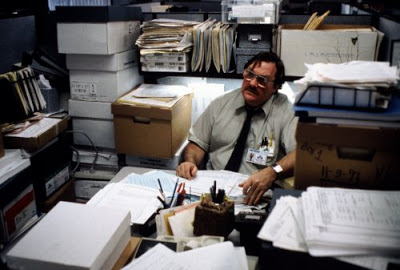For decades, we’ve been promised a paperless office, yet my hands are still covered in bloody, weeping sores.
It’s not a surprise that reams and sheets and post-its have persisted into the era of tablets and smartphones, as horse-drawn carriages and trolleys shared the roads with automobiles during the early years of the latter’s introduction. (The final horse-driven tram in NYC was still on the streets in 1917.)
So far, the many descendants of papyrus have persevered, showing no sign of truly disappearing from desks and portfolios, though Christopher Mims of the Wall Street Journal believes the decline may finally have begun. Electronic signatures and the like have for the first time in history led to a “steady decline of about 1% to 2% a year in office use of paper,” Mims writes. The downside to clutter is that while paper leaves a trail, it isn’t prone to instantaneous surveillance like our newer techologies.
The opening:
Every year, America’s office workers print out or photocopy approximately one trillion pieces of paper. If you add in all the other paper businesses produce, the utility bills and invoices and bank statements and the like, the figure rises to 1.6 trillion. If you stacked all that paper up, it would be 18,000 times as high as Mount Everest. It would reach nearly halfway to the moon.
This is why HP Inc.’s acquisition of Samsung Electronics Co.’s printing and copying business last week makes sense. HP, says a company spokesman, has less than 5% of the market for big, high-throughput office copying machines. The company says the acquisition will incorporate Samsung’s technology in new devices, creating a big opportunity for growth.
Yet by all rights, this business shouldn’t exist. Forty years ago, at least, we were promised the paperless office. In a 1975 article in BusinessWeek, an analyst at Arthur D. Little Inc., predicted paper would be on its way out by 1980, and nearly dead by 1990.•
Tags: Christopher Mims

